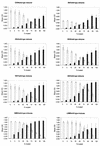Rapid and sensitive oligonucleotide ligation assay for detection of mutations in human immunodeficiency virus type 1 associated with high-level resistance to protease inhibitors
- PMID: 11923366
- PMCID: PMC140364
- DOI: 10.1128/JCM.40.4.1413-1419.2002
Rapid and sensitive oligonucleotide ligation assay for detection of mutations in human immunodeficiency virus type 1 associated with high-level resistance to protease inhibitors
Abstract
A sensitive, specific, and high-throughput oligonucleotide ligation assay (OLA) for the detection of genotypic human immunodeficiency virus type 1 (HIV-1) resistance to Food and Drug Administration-approved protease inhibitors was developed and evaluated. This ligation-based assay uses differentially modified oligonucleotides specific for wild-type or mutant sequences, allowing sensitive and simple detection of both genotypes in a single well of a microtiter plate. Oligonucleotides were designed to detect primary mutations associated with high-level resistance to amprenavir, nelfinavir, indinavir, ritonavir, saquinavir, and lopinavir, including amino acid substitutions D30N, I50V, V82A/S/T, I84V, N88D, and L90M. Plasma HIV-1 RNA from 54 infected patients was amplified by reverse transcription-PCR and sequenced by using dideoxynucleotide chain terminators for evaluation of mutations associated with drug resistance. These same amplicons were genotyped by the OLA at positions 30, 50, 82, 88, 84, and 90 for a total of 312 codons. The sensitivity of detection of drug-resistant genotypes was 96.7% (87 of 90 mutant codons) in the OLA compared to 92.2% (83 of 90) in consensus sequencing, presumably due to the increased sensitivity of the OLA. The OLA detected genetic subpopulations more often than sequencing, detecting 30 mixtures of mutant and wild-type sequences and two mixtures of drug-resistant sequences compared to 15 detected by DNA sequencing. Reproducible and semiquantitative detection of the mutant and the wild-type genomes by the OLA was observed by analysis of wild-type and mutant plasmid mixtures containing as little as 5% of either genotype in a background of the opposite genome. This rapid, simple, economical, and highly sensitive assay provides a practical alternative to dideoxy sequencing for genotypic evaluation of HIV-1 resistance to antiretrovirals.
Figures

References
-
- Balotta, C., A. Berlusconi, A. Pan, M. Violin, C. Riva, M. C. Colombo, A. Gori, L. Papagno, S. Corvasce, R. Mazzucchelli, G. Facchi, R. Velleca, G. Saporetti, M. Galli, S. Rusconi, and M. Moroni. 2000. Prevalence of transmitted nucleoside analogue-resistant HIV-1 strains and pre-existing mutations in pol reverse transcriptase and protease region: outcome after treatment in recently infected individuals. Antivir. Ther. 5:7-14. - PubMed
-
- Baxter, J. D., D. L. Mayers, D. N. Wentworth, J. D. Neaton, M. L. Hoover, M. A. Winters, S. B. Mannheimer, M. A. Thompson, D. I. Abrams, B. J. Brizz, J. P. Ioannidis, T. C. Merigan, et al. 2000. A randomized study of antiretroviral management based on plasma genotypic antiretroviral resistance testing in patients failing therapy. AIDS 14:F83-F93. - PubMed
-
- Condra, J. H., D. J. Holder, W. A. Schleif, O. M. Blahy, R. M. Danovich, L. J. Gabryelski, D. J. Graham, D. Laird, J. C. Quintero, A. Rhodes, H. L. Robbins, E. Roth, M. Shivaprakash, T. Yang, J. A. Chodakewitz, P. J. Deutsch, R. Y. Leavitt, F. E. Massari, J. W. Mellors, K. E. Squires, R. T. Steigbigel, H. Teppler, and E. A. Emini. 1996. Genetic correlates of in vivo viral resistance to indinavir, a human immunodeficiency virus type 1 protease inhibitor. J. Virol. 70:8270-8276. - PMC - PubMed
Publication types
MeSH terms
Substances
Grants and funding
LinkOut - more resources
Full Text Sources
Other Literature Sources

